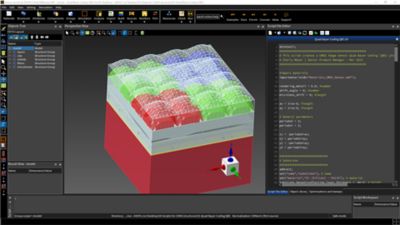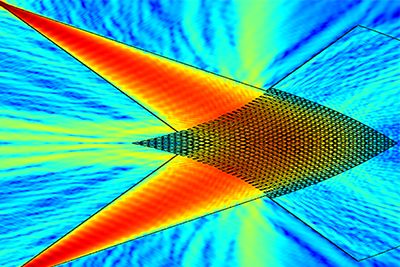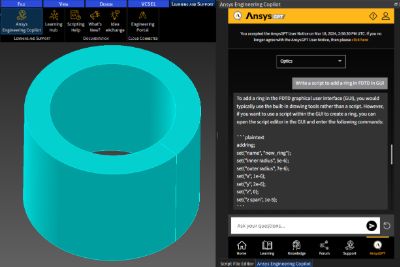クイックスペック
Ansys Lumerical FDTDは高速、正確、スケーラブルなフォトニック設計を可能にするために、Ansys Lumerical CML Compiler、マルチフィジックスソルバー、Ansys Speos、Ansys Zemax、サードパーティの電子-フォトニック設計の自動化(EPDA)ベンダーとシームレスに連携します。
Ansysは次世代の技術者を支援します
学生は、世界クラスのシミュレーションソフトウェアに無料でアクセスできます。
未来をデザインする
Ansysに接続して、シミュレーションが次のブレークスルーにどのように貢献できるかを確認してください。
Ansys Lumerical FDTDは、フォトニクスコンポーネント、プロセス、および材料のモデリングのゴールドスタンダードです。この統合設計環境は、スクリプト機能、高度なポストプロセス、最適化手法を備えています。
Ansys Lumerical FDTDは、単一の設計環境にFDTD、RCWA、およびSTACKソルバーを統合するフォトニックシミュレーションソフトウェアです。回折格子、多層コーティング、uLED、CMOSイメージセンサー、メタレンズ、メタサーフェスなど、多岐にわたるデバイスの正確な解析と最適化が可能になり、さまざまな用途にクラス最高の性能をもたらします。Ansys Lumerical FDTDは、最も複雑な設計に対して数千回の反復の迅速な仮想プロトタイピングと検証を可能にします。

Ansys Lumerical FDTDは高速、正確、スケーラブルなフォトニック設計を可能にするために、Ansys Lumerical CML Compiler、マルチフィジックスソルバー、Ansys Speos、Ansys Zemax、サードパーティの電子-フォトニック設計の自動化(EPDA)ベンダーとシームレスに連携します。

「Ansys Lumericalシミュレーションソフトウェアは、精度、互換性、使いやすさ、サポートに関する当社の基準を満たし、フォトニックデバイスを自信を持って設計および最適化することができました。このソフトウェアにより、製造プロセスデータを簡単に統合して、実用的で現実的なシミュレーション結果を得ることができました」

「最適化、スクリプト作成、およびクラウドのサポートを備えたAnsys Lumericalを使用することで、当社の8倍の回路のコンポーネントすべてを最適化して、これまでにない低損失性能、コンパクト性、高い製造公差を実現することができました」

「Ansys Lumerical FDTDを当社のクラウドのアクセラレータと組み合わせることで、設計スケジュールを大幅に短縮しながら、挿入損失を15%以上削減することができました」

「Lumerical FDTDは当社の研究開発体制に不可欠な要素です。使いやすいレイアウトのおかげで、短期間のプロジェクトを迅速に設定できます。またそれと同時に、スクリプト機能、ドキュメント、およびサンプルを使用して、着実かつ効果的にテクノロジーを進歩させることができました」

「Lumerical FDTDを使用することで、製造を考慮した高精度のマイクロキャビティOLEDモデルを一連のカスタムスクリプトから作成しました。Lumericalは時間とコストの両方を削減するのに役立ちました。引き続き、現在の特許取得済みの方法を実行してOLEDの光学構造を調整するための主要なツールとして使用しています」

「Ansys Lumerical FDTD、AWS、Python APIを併用して、CMOS製造公差と互換性を持たせながら、このメタサーフェスをナノメートル単位ですべて設計しました。LumericalのAWSソリューションにより、精度を落とさず、そして追加コストなしに、当社の設計サイクル時間を2~3桁ほど短縮できました」

「成熟度が高く近似のないFDTD法を使用した大規模な物理シミュレーションを実行できるため、かつてない確信をもってテープアウトに臨むことができます。LumericalのFDTDベースのHPCアプローチは、最速かつ最も費用対効果が高いことが証明されました」

「Lumericalのソフトウェアは、私たちの研究にとって非常に貴重なものでした。市場をリードする評判を維持するために、非常に便利な機能が継続的に追加されています」
2025年7月
Ansys Lumerical FDTDの最新リリースでは、GPUアクセラレーション、逆設計、CADの相互運用性の新機能が追加され、次世代フォトニクスシステムの設計者に優れた柔軟性と拡張性をもたらします。

マルチノード、マルチGPU実行のサポートにより、大規模な電磁界シミュレーションを複数のGPUとコンピューティングノードに分散させることができるため、複雑な3Dフォトニクス構造の実行時間が大幅に短縮されます。

Ansys Cloud Burst ComputeはAnsys Lumerical FDTDに組み込まれました。インストールや設定を必要としないSaaS(Software-as-a-Service)機能を使用して、Lumerical FDTDデスクトップからAnsysが管理するクラウドコンピューティングリソースに、Lumerical FDTDジョブをオンデマンドで送信できるようになりました。

最新版のAnsys Lumerical FDTDでは、GPUアクセラレーションによるシミュレーションが導入され、メモリの大幅な節約とメッシング時間の短縮が可能になります。こうした機能強化により、フォトニクス分野のエンジニアや研究者は、効率を高めながら大規模なシステムをシミュレーションできるようになり、性能を損なうことなく、より複雑な設計やシステムに容易に取り組むことができます。

Ansys Engineering CopilotはAnsys Lumerical FDTDに組み込まれ、製品内からAIアシスタントにアクセスできるようになりました。

レイヤーの繰り返し機能では、繰り返しレイヤーの複数の独立したグループを設定できます。主な用途には、ボリュームホログラム回折格子(VHG)や光計測などがあります。

Ansys Lumerical FDTDでは、Parasolid、SolidWorks、CATIA、Autodesk Inventor、およびACISファイルからCADオブジェクトをインポートできるようになりました。

機能
Lumerical FDTDは、幅広いフォトニックコンポーネントの設計と最適化を行うための、業界をリードするシミュレーションソフトウェアです。汎用性と拡張性に非常に優れ、比類のない速度とHPC(CPUおよびマルチGPU)およびクラウドのリソースを活用する機能を提供します。

エンジニアの作業時間の34%はシミュレーションデータの検索に費やされています。このビデオでは、このような課題をAnsys Minervaで解決し、エンジニアの生産性を高める方法について説明します。
シミュレーションプロジェクトに伴う複雑さを軽減し、チームメンバーが協調して作業できるようにすることで、時間を節約し、プロジェクト全体で一貫したベストプラクティスを確実に実行できます。

Ansysは、障がいを持つユーザーを含め、あらゆるユーザーが当社製品にアクセスできることがきわめて重要であると考えています。この信念のもと、US Access Board(第508条)、Web Content Accessibility Guidelines(WCAG)、およびVoluntary Product Accessibility Template(VPAT)の最新フォーマットに基づくアクセシビリティ要件に準拠するよう努めています。
エンジニアリング課題に直面している場合は、当社のチームが支援します。豊富な経験と革新へのコミットメントを持つ当社に、ぜひご連絡ください。協力して、エンジニアリングの障害を成長と成功の機会に変えましょう。ぜひ今すぐお問い合わせください。


